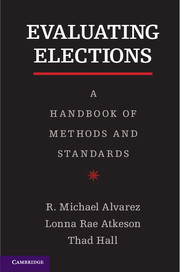Book contents
- Frontmatter
- Contents
- Acknowledgments
- Introduction
- 1 The Electoral Ecosystem
- 2 Easily Available Data for Performance Evaluation
- 3 Measuring the Experiences of Voters
- 4 Measuring the Performance of Poll Workers
- 5 Auditing the Election Ecosystem
- 6 Election Observation
- Conclusion
- Appendix: Precinct Opening, Closing, Election Day Forms
- References
- Index
5 - Auditing the Election Ecosystem
Published online by Cambridge University Press: 05 December 2012
- Frontmatter
- Contents
- Acknowledgments
- Introduction
- 1 The Electoral Ecosystem
- 2 Easily Available Data for Performance Evaluation
- 3 Measuring the Experiences of Voters
- 4 Measuring the Performance of Poll Workers
- 5 Auditing the Election Ecosystem
- 6 Election Observation
- Conclusion
- Appendix: Precinct Opening, Closing, Election Day Forms
- References
- Index
Summary
Election administration is a highly complex process that involves multiple actors all working to achieve the goal of running an effective election. Accomplishing this goal requires election officials coordinating the efforts of contractors (from ballot printers to voting machine companies), third parties (like the U.S. Postal Service, which transports absentee ballots, and the entities that agree to house polling places), and the poll workers who actually implement the election at the polls. Managing this vast enterprise of actors within the organization and across a network of outside actors requires election officials to evaluate their election activities so that they can improve the implementation of the process over time (O’Toole and Meier 1999).
One important way to gather the performance data needed to improve election management is through an election ecosystem audit (EEA). These audits are evaluations of an election from start to finish that especially emphasize the administrative aspects of the election process. This type of evaluation uses both existing data that are collected as a matter of course in the election process and new data that are specifically generated for this purpose. Postelection voting machine performance audits – where the original count of the election is compared with a postelection hand count of ballots – is an example of this latter type.
- Type
- Chapter
- Information
- Evaluating ElectionsA Handbook of Methods and Standards, pp. 115 - 129Publisher: Cambridge University PressPrint publication year: 2012
- 2
- Cited by



